On entering high school was the first time that I explored Chemistry properly, and I’ve come to enjoy it quite a bit. It does not seem to be as straightforward as Physics, or require as much memory as Biology. Of course, all three are wonderful in their own ways but I’ve come to love the Periodic Table, especially upon repeated study.
Today’s modern table was framed by Dmitri Mendeleev, who uniquely arranged the then-known elements by the increasing order of their masses and similarities in their properties. He left spaces for undiscovered elements, and accurately predicted their properties too!





To me, the more fascinating part is that the arrangement of elements by their atomic numbers, has allowed patterns to surface (of course, there are exceptions) for so many periodic properties. For example, the ionization potentials, electronegativity, oxidising effects and acidic properties of elements increase along a given period and decrease along a given group.

All the metals, metalloids, non metals etc. are found on various sides of the periodic table.
113, 115, 117, 118 are now Nihonium, Moscovium, Tennessine and Oganesson.
The Modern Periodic Table
And it’s just incredible how everything around us is made up of 90 or so (main) elements in just a bunch of different combinations.
Speaking of combining stuff, I was totally enamoured when I started learning the basics of organic chemistry. Just by the tetra-valency of carbon, it’s able to link up over and over again to form long chains, so fantastically that life itself forms.
My favourite thing though, is to name the compounds. The IUPAC system is clear, giving us an order on what to spot in a compound and thus how we can name it. For example, we identify the number of main Carbon atoms, the bond order, functional groups etc. and begin the naming process.

- Identify that there are 3 C atoms in a path without deviation, implying that this is Prop-.
- All are single bonds – this is an alkane, Propane.
- There is a functional group – CH3 – methyl. This is methyl-propane.
- But which C atom is it attached to? Number the atoms such that the attached Carbon is at the lowest possible number. This is 2-methylpropane.
Recently, I started learning about hybrid orbitals and chemical bonding, and my mind is reeling at how infinitely complex everything seems.
But this was a little something I wanted to share, even if it’s all already known to you. It’s also a reminder to myself about the fundamental, elemental beauty that is Chemistry, whenever I get a little too frustrated about it.
I hope you liked reading this post!

Very interesting – especially for a non-science student like me! Well written!
LikeLiked by 1 person
Thank you!
LikeLike
slightly terrified to go into 10th now
LikeLiked by 1 person
You’ll love it soon
LikeLiked by 1 person